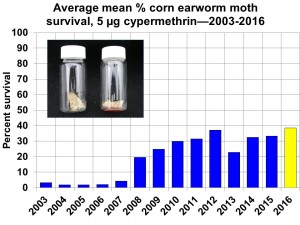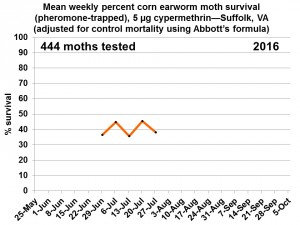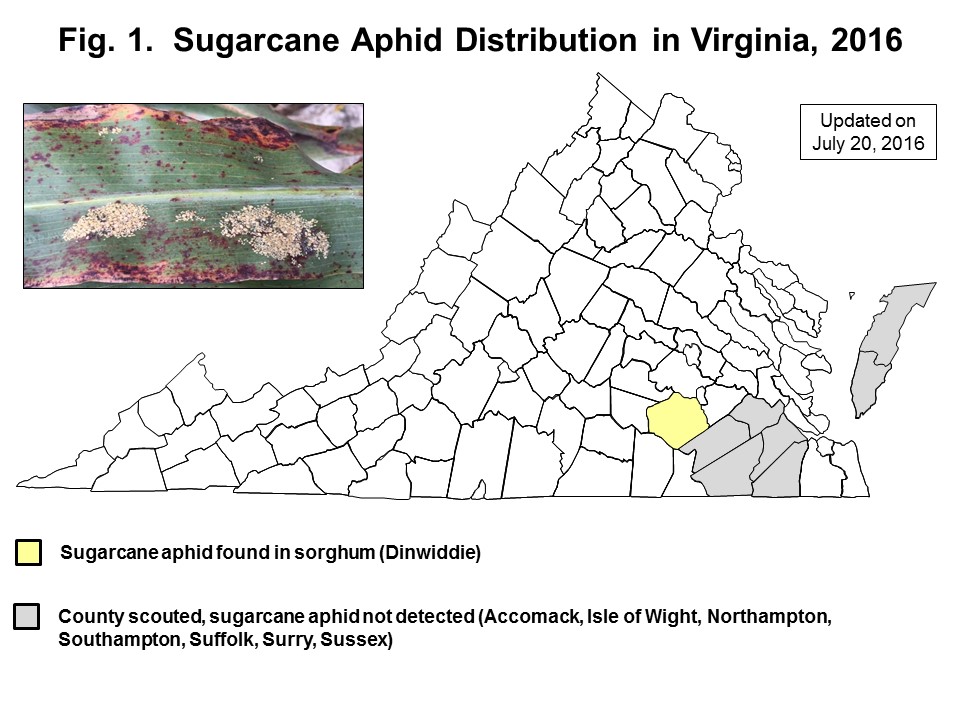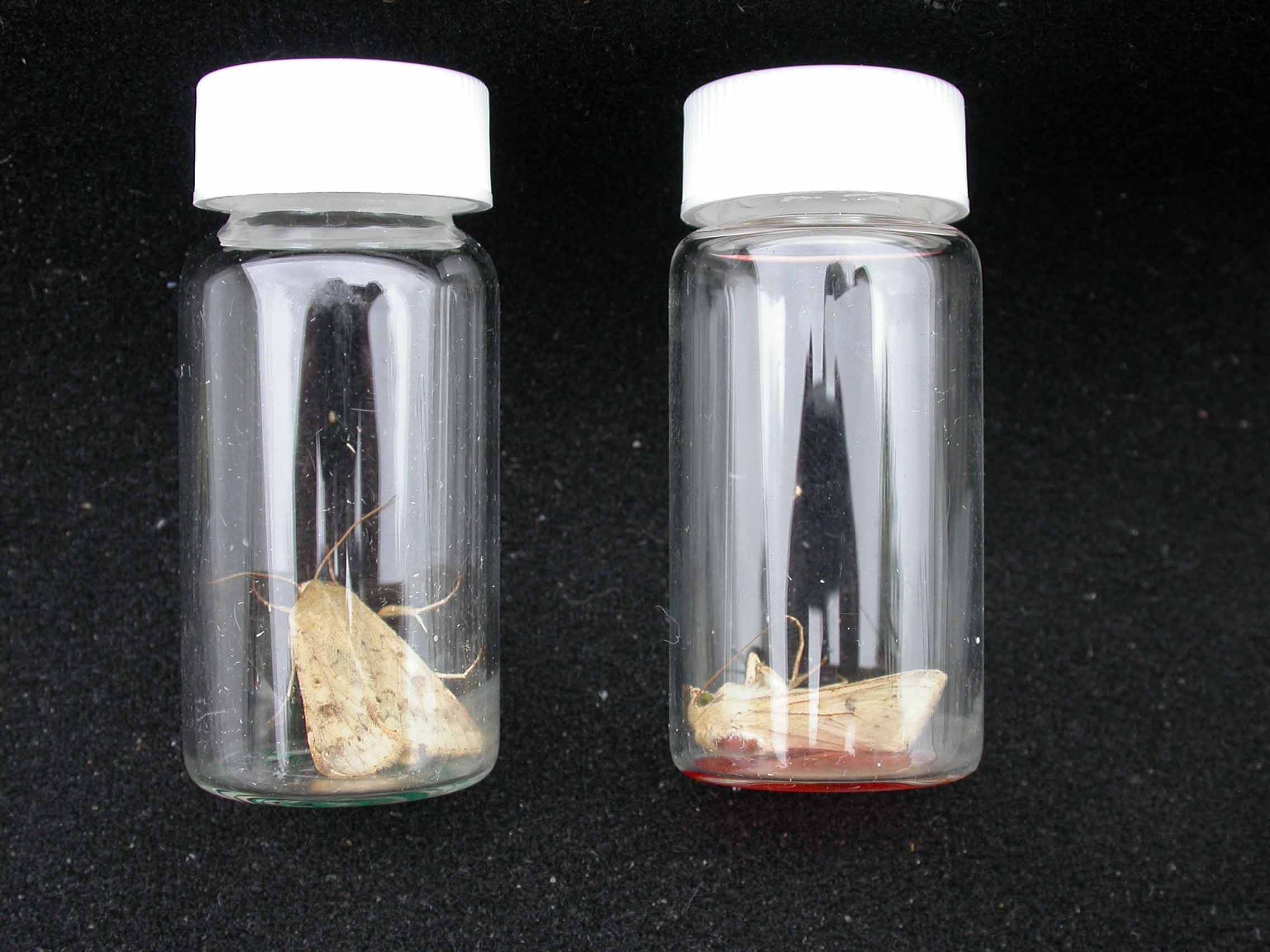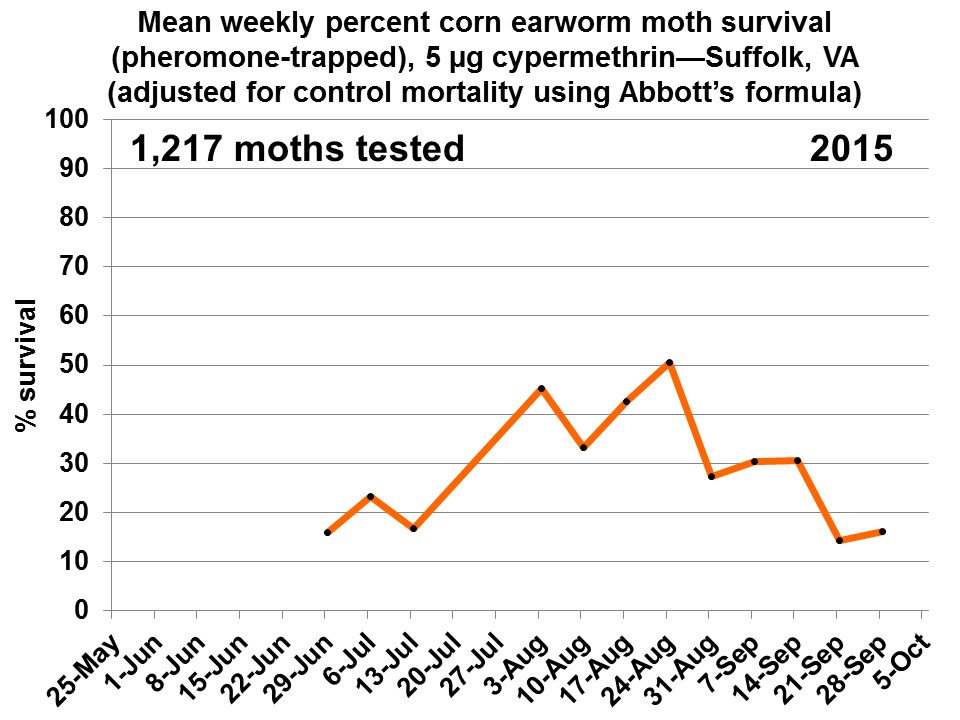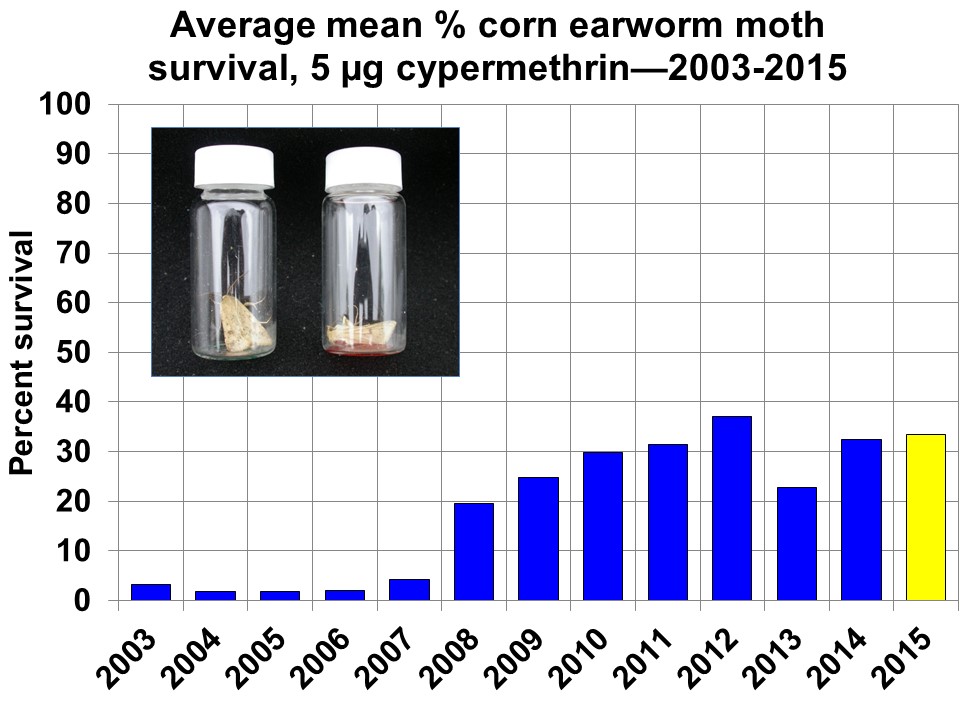We have vial-tested 444 moths in 2016, with a mean of 38.5% surviving the 24-hour exposure to the pyrethroid insecticide cypermethrin at 5 micrograms. These moths all were captured in Suffolk pheromone traps. While we aren’t able to say where these moths originated (they are strong fliers and could have grown up locally or far away), survival rates this high serve as a reminder that alternative (i.e., non-pyrethroid) chemistries may need consideration for corn earworm (bollworm) management, especially if heavy infestations develop. We are working with Johnny Parker and some Southampton Co. growers to trap in an area reported to have high numbers of corn earworm moths near Franklin–results of the vial testing in that location will be available next week.
Author Archives: Sean Malone
Corn earworm and brown marmorated stink bug update for July 21, 2016
Black light trap captures of corn earworm (bollworm) moths remain low, averaging zero to 2 moths per night in area traps. The brown marmorated stink bug averaged zero to 2.3 per night. Thanks to Livvy Preisser and Neil Clark (Southampton), Mary Beahm (Warsaw), Mike Parrish and Ray Clarke (Dinwiddie), Scott Reiter (Prince George), and the Tidewater AREC Entomology crew for their reports this week. Please click on the attached pdf at the end of this sentence for the weekly data tables for these two insects. BLT_21_Jul_2016
Our pyrethroid resistance monitoring of corn earworm (bollworm) in the adult vial tests indicate an average survival rate of 38.6% for a 24-hour exposure to 5 micrograms of cypermethrin. Weekly percent survival has ranged from approximately 36-45%.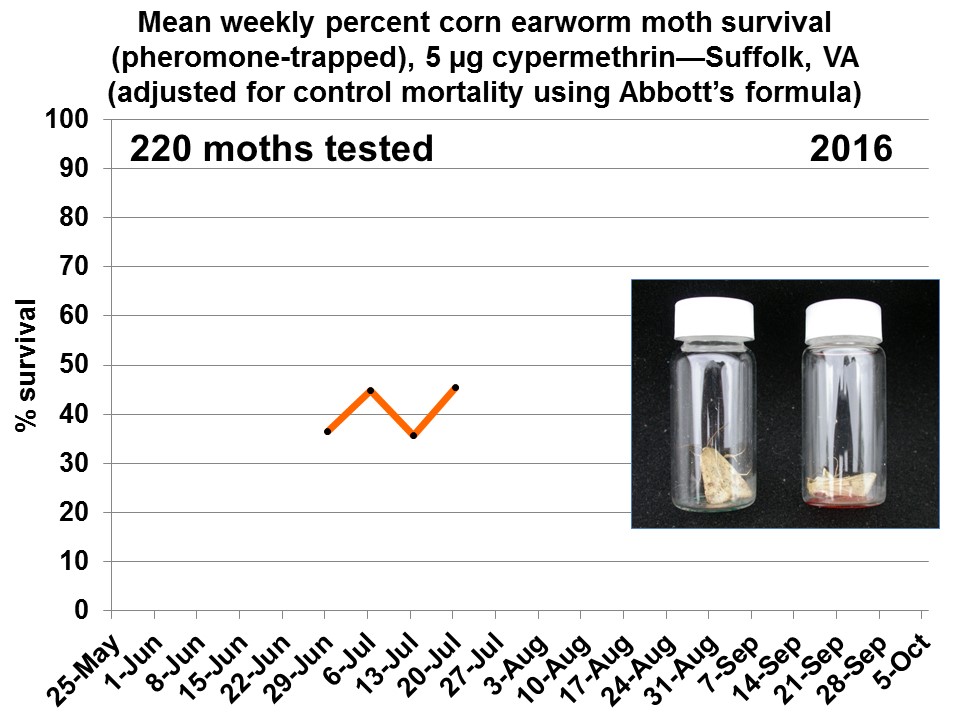
Sugarcane Aphid Found in Dinwiddie County, Virginia
On July 20, 2016, Virginia Cooperative Extension Agent Mike Parrish submitted an insect sample collected from sorghum in Dinwiddie County, VA, that we confirmed as sugarcane aphid (Melanaphis sacchari). Last year, this aphid was not found in Virginia until late September (in Isle of Wight, Prince George, Southampton, Suffolk, Surry, and Sussex Counties). Infestations can stunt or even kill sorghum plants that are in the pre-head stage, and after heading the honeydew can interfere with mechanical harvest by plugging up combines.
Researchers at the Virginia Tech Tidewater and Southern Piedmont Agricultural Research and Extension Centers (Dr. Maria Balota’s crew, including Dr. Joseph Oakes; the Entomology crew; and Dr. Chris Teutsch) have been scouting sorghum for several weeks now—please see Figure 1 for our current findings.
With sugarcane aphids’ ability to spread and reproduce rapidly, sorghum scouting should begin immediately and be conducted at least weekly. Start with sorghum field edges, especially checking the underside of lower leaves. Leaves that are shiny with honeydew are a clue that aphids are present on that plant. Once aphids are found, scouting should be conducted at shorter intervals to actively monitor population growth. The economic thresholds for treatment of sugarcane aphid are provided in Table 1 and are based on North Carolina Cooperative Extension recommendations.
Table 1. Economic thresholds for treatment of sugarcane aphid in sorghum.
| Growth Stage | Threshold |
| Pre-boot | 20% infested plants with localized area of honeydew and established aphid colonies |
| Boot | 20% infested plants with localized area of honeydew and established aphid colonies |
| Flowering-milk | 30% infested plants with localized area of honeydew and established aphid colonies |
| Soft dough | 30% infested plants with localized area of honeydew and established aphid colonies |
| Dough | 30% infested plants with localized area of honeydew and established aphid colonies |
| Black layer | Heavy honeydew and established aphid colonies in head (treat to avoid problems at harvest) |
Thresholds in this table are from Sugarcane Aphid Now Present in NC-2016 https://entomology.ces.ncsu.edu/2016/07/sugarcane-aphid-now-present-in-nc-2016/ by Dr. Dominic Reisig, Associate Professor and Extension Specialist, NCSU.
In Virginia, two insecticides are recommended for sugarcane aphid control in sorghum, Sivanto (which has a FIFRA Section 2(ee) Recommendation for a reduced rate, including Virginia), and Transform WG (which is registered under a Section 18 emergency exemption for Virginia) (Table 2). Repeat applications should rotate chemistries. Good coverage of the plant with insecticides is essential for effective control. A minimum spray volume of 10 gpa is recommended. Please be sure to carefully read and follow the label.
IMPORTANT NOTE: Insecticides with pyrethroid as the active ingredient are NOT recommended for the control of sugarcane aphid. The efficacy of pyrethroid insecticides against the sugarcane aphid is low and they negatively impact the population of natural predators. This often results in a rapid increase in sugarcane aphid populations immediately following application.
Table 2. Insecticides recommended for the control of sugarcane aphid in sorghum.
| Insecticide | Active Ingredient | Application Rate | Max Annual Application Rate | Pre-Harvest Interval |
| oz/A | oz/A/year | days | ||
| Sivanto | flupyradifurone | 4-7 | 28 | 7 (forage) AND 21 (grain) |
| Transform WG | sulfoxaflor | 0.75-1.5 | 3.0 | 7 (forage) AND 14 (grain) |
For more information on the sugarcane aphid, please contact your local extension agent. Contact information can be found at http://www.ext.vt.edu/offices/index.html.
Corn earworm and brown marmorated stink bug update for July 14, 2016
Black light trap captures of corn earworm moths have been very low this past week in Suffolk (2 total moths) and Warsaw (zero moths). Captures in the Suffolk pheromone traps also dropped off this week. However, field corn and sweet corn samples suggest that we may see higher numbers of corn earworm (aka bollworm) in other crops this season.
We have started catching brown marmorated stink bug (BMSB) in the black light traps in Suffolk (5 total in the past week) and in Warsaw (4 total this week). I don’t recall ever catching that many in Suffolk before. Our soybean scouts are beginning their statewide survey for BMSB (and kudzu bug) and we will keep you informed on these pest population levels throughout the season.
Sugarcane aphid update for July 14, 2016
Our team has been scouting sorghum for sugarcane aphid in Isle of Wight, Southampton, Suffolk, and Sussex counties, but we have not detected them yet this season. They have been found in North Carolina, and with their ability to spread and reproduce rapidly, we recommend starting to scout sorghum for this pest.
There are several aphid species that can be found in sorghum, but sugarcane aphids are cream yellow in color with two, short dark cornicles (“tailpipes”) on their hind end. Start weekly scouting at the field edges, especially checking the underside of lower leaves. Once insects are found, scouting should be conducted at shorter intervals to actively monitor population growth. Dr. Dominic Reisig, Extension Entomologist at North Carolina State University, provides these thresholds for sugarcane aphid.
When pesticides are needed, we recommend Sivanto (which has a FIFRA Section 2(ee) Recommendation for a reduced rate of 4-7 oz/A, including Virginia), or Transform WG (which is registered under a Section 18 emergency exemption for Virginia at a rate of 0.75-1.5 oz/A). Good coverage is essential. Please refer to (and follow!) the labels for more details, including the maximum amount that can be applied annually, pre-harvest intervals, etc. Repeat applications, when needed, should rotate active ingredients. Pyrethroids are not recommended.
Corn earworm update for July 7, 2016
Our black light trap at the Tidewater AREC in Suffolk is just now beginning to catch low numbers of corn earworm moths–we had 4 total this past week. The Eastern Virginia AREC in Warsaw is not catching them yet.
We have caught some corn earworm moths in our pheromone traps in Suffolk (pheromone traps often out-perform black light traps early in the season for this species). We have conducted vial tests on 160 moths since late June, and have seen quite high levels of survival for the start of the season (an overall average of 38.6% of moths surviving the vial test). As in the past, we are exposing these moths for 24 hours to vials treated with a standard pyrethroid insecticide, cypermethrin, at 5 micrograms per vial. For comparison, in 2015 we had about 21% survival at this time of the season, with a peak survival rate of 51% occurring in late August. We will continue to provide updates on this issue.
Stakeholder input on Virginia’s State Pollinator Protection Plan
The following advisory is posted on behalf of Dr. Hunter Frame:
I want everyone to check out this letter for stakeholder input on the pollinator protection plan that is being developed by VDACS. So for the cotton producers the nearest meeting will be on February 22 from 6-8 pm at the Tidewater Agricultural Research and Extension Center in Suffolk, VA. This is an important issue that needs to be discussed and solutions need to be developed so no tools for producers are lost and bees/beekeepers are able to thrive next to cotton and other crops! Look forward to seeing everyone there!
http://www.vdacs.virginia.gov/pdf/pollinatorprotectionplanletter.pdf
Helicoverpa zea (corn earworm/bollworm) adult vial test update for Sep. 24, 2015
We’re not catching many moths in our pheromone traps this time of year, but we are still conducting the adult vial tests on those that we do catch. We are currently seeing many more dead moths after 24 hours of exposure to the pyrethroid insecticide, cypermethrin, at the 5 microgram per vial rate. Less than 20% as you can see in the line graph below. For the season, the average survival rate is 33.4% (bar chart, below).
Sugarcane aphids found in Isle of Wight sorghum field (Sep. 18, 2015)
Another Virginia county has been found with sugarcane aphid in sorghum. Please see the attachment for more details. SCA_advisory_Sep_18_2015
Sugarcane aphids found in sorghum field in Suffolk, Virginia
Dr. Ames Herbert confirmed the presence of sugarcane aphids, Melanaphis sacchari, in a sorghum field at the Tidewater Agricultural Research and Extension Center in Suffolk, Virginia, on Sep. 17, 2015. Sugarcane aphid spreads as winged adults on wind and storm fronts so infestations can spread rapidly—so to be on the safe side, sorghum fields should be scouted.
There are several other aphid species that can infest sorghum but sugarcane aphid can be differentiated from the others being smooth, cream yellow, with two, short dark cornicles (“tailpipes”) on the hind end.
Research by Mike Brewer, Texes AgriLife, and David Kerns, LSU, has provided the most up-to-date Econominc Injury Level (EIL) of 50 to 125 aphids per leaf at sorghum prices of $4/bu; and the currently recommended Economic Threshold (when the insecticide needs to be applied to prevent the population from reaching the EIL) of 25 – 30% infested plants with 50 aphids per leaf.
After heading, according to work in other states, one of the more effective insecticide products is Sivanto (Bayer CropScience). Please refer to the Section 2(ee) Recommendation for the lower (but effective) rate of Sivanto @ 4-7 oz/A here: http://www.cdms.net/ldat/ldC4K023.pdf (please take note of the pre-harvest intervals and other directions found in the Section 2(ee)).

